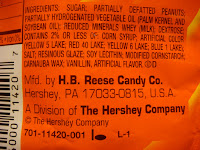Rice a Roni Chicken and Rice flavor
Ingredients
RICE, WHEAT FLOUR, DURUM WHEAT SEMOLINA, SALT, SUGAR, AUTOLYZED
YEAST EXTRACT*, HYDROLYZED SOY PROTEIN, ONIONS*, MONOSODIUM GLUTAMATE,
NATURAL FLAVOR, PARSLEY*, GARLIC*, CHICKEN BROTH*, CHICKEN FAT, TURMERIC
SPICE WHICH IMPARTS COLOR, HYDROLYZED CORN GLUTEN, NIACIN*, DISODIUM
GUANYLATE, DISODIUM INOSINATE, FERRIC ORTHOPHOSPHATE, FERROUS SULFATE,
THIAMIN MONONITRATE, TURMERIC EXTRACT, FOLIC ACID, RIBOFLAVIN.
Autolyzed Yeast Extract, Hydrolyzed Soy Protein and Monosodium Glutamate. The first two are big food's newest entries into the MSG market, new products that do in fact have specific functions, primarily cheap fillers, but are added mostly because they contain very high percentages of free glutamates. Three different forms of MSG in one product. MSG is the go to ingredient that makes mediocre things taste better. MSG is also classified as an excitotoxin in that it has been shown to destroy the retinas of test mammals and it damages nerve cells in vitro. Learn more about MSG here (MSG Info) Last things to mention here are the two RIBOTIDES, Guanylate and Inosinate. Both are not inherently bad, and in reality I only mention them because of their use in food processing is to impart more of that umami flavor, an actual sensation of taste rather than actual taste. They both perform pretty much the same function as the other three MSG with out the bad side effects like killing your brain cells. Think about it, what would the stuff taste like if it didn't have flavor enhancers?
Hydrolyzed Corn Gluten was first created at Iowa State University in 1985 as a byproduct in processing of corn. Professor Nick Christians received two patents for the stuff in 1991 and 1993 for believe it or not, as an incredibly effective herbicide. It seems that when mixed with water and sprayed on fields, it prevented plants from growing. Everything, all plants. It had limited usage in agriculture, I mean it killed all the plants. But, it's okay for you to eat. Here it's used as filler I would imagine, I'm not privy to their secrets.
The last things to mention here are two common ingredients in processed foods, salt and sugar. There's more salt and sugar in this Chicken and Rice product than there is chicken.
I eat a lot of rice myself. Organic long grain brown rice. From California, I try to stay away from the rice grown in the South as it is pretty much all contaminated with Arsenic. But I do eat a lot of the stuff. I make it all the time, reheat it, fry it, make pilafs and jambolayas and as a base for curries and paella and whew, I eat it all the time. And it tastes pretty good. And none of it has all that crap in it that Rice A Roni does. Real cooking isn't hard to do, you already have the internet, look up something, try it, it has to be better than the stuff in a box.
 specifically had on the label the inherent mouth feel of the product. Most notable, Frito-Lays new line of Doritos called Jacked. Thicker and with more crunch than regular Doritos. Is it a bad thing? No, not really. It's just one more expression of the measures that large food manufacturers will do to garner market share and to ultimately get consumers addicted to their products.
specifically had on the label the inherent mouth feel of the product. Most notable, Frito-Lays new line of Doritos called Jacked. Thicker and with more crunch than regular Doritos. Is it a bad thing? No, not really. It's just one more expression of the measures that large food manufacturers will do to garner market share and to ultimately get consumers addicted to their products. 







